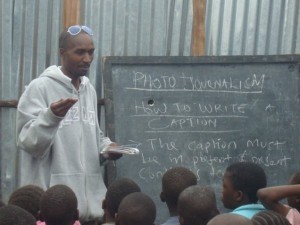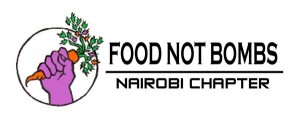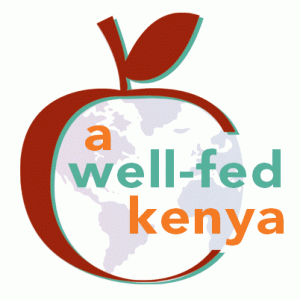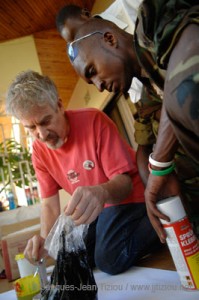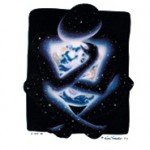Protected: Fiopa, formerly Heathcote Earthings, LLC. Looking for Storefront
Subscribe to this blog's RSS feed
A Well-Fed Kenya: Food and Photojournalism
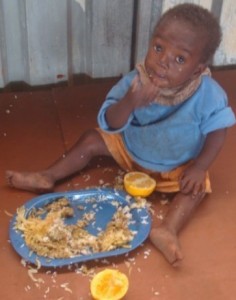 Some stories enter my bones and don’t leave. The story of Nairobi Food Not Bombs is in my marrow and vibrating, refusing to be ignored.
Some stories enter my bones and don’t leave. The story of Nairobi Food Not Bombs is in my marrow and vibrating, refusing to be ignored.
As C.T.’s partner, I’m a witness to the daily news feed of Food Not Bombs arrests and court cases, mostly here in the U.S. In addition, he gets a steady stream of calls all day, mostly people asking advice on consensus and also starting a Food Not Bombs.
One such FNB startup was germinated from C.T.’s trip to Nairobi, Kenya, in 2007. He was there to teach consensus at the IndyMedia Convergence, in advance of the World Social Forum.
IndyMedia is an amazing case study in do-it-yourself journalism, personal and collective empowerment. IMC “converges” at the site of each World Social Forum, a week or so before the WSF begins, to teach grassroots journalism to non-corporate press from all over the world.
The convergences are temporary Intentional Communities that operate by consensus. Workshops teach would be journalists from Africa, South and Central America, Europe and the U.S. in street-level skills like building radios and transmitters out of materials available where they live.
At the Nairobi convergence, C.T. taught consensus and also pulled a hidden skill out of his hat—He taught IMC participants how to build a silkscreen press! This knowledge came from his early days of battling
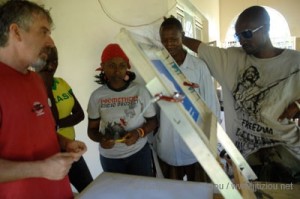
C.T. teaches IMC journalists how to build and use a 3-color silkscreen press to generate fliers, books, posters, t-shirts, etc.
Seabrook Nuclear Power Plant, starting the first FNB collective, the start of ACTUP, etc.
The convergences are meetings of very different cultures. In Nairobi, C.T. was the “old guy.” While the Northerners (Europeans and Americans) gave him little rank and dismissed his efforts to teach, Africans sought him out and revered him as the elder in the group.
One such new friend erased C.T.’s name from a community chore chart and wrote his own in its place. “In my culture, elders do not do the dishes,” He said.
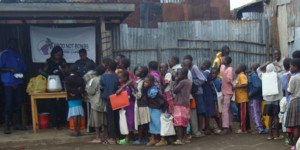 Douglas Rori, a convergence participant who was local to Nairobi, was so taken by C.T.’s stories of Food Not Bombs that he started a Nairobi chapter.
Douglas Rori, a convergence participant who was local to Nairobi, was so taken by C.T.’s stories of Food Not Bombs that he started a Nairobi chapter.
A Totally Different Ballgame
But unlike the twentysomethings who start chapters in their Midwestern college towns or face up against the police in Tampa, Florida, Doug and his Nairobi compatriots couldn’t just show up in the town square or public park with a table and pots of yummy vegan soup.
That’s a recipe for a food riot.
The hunger issue is not a minority issue there. Public feedings such as FNB is famous for the world over would put Doug and other volunteers at physical risk. Plus, with their food stolen, they would not complete their goal of serving the large population of street kids, mostly orphaned in the AIDS epidemic.
Sewing in the IndyMedia Thread
This is where the story gets dramatic in order to prevent drama.
Doug and other young Kenyan activists had the direct experience of how empowering it is to learn tools for telling personal and local stories; to be an alternative to the corporate press party line.
And they had learned filmmaking, photography and journalism in that way. Doug decided to disguise their feedings by offering journalism workshops to the homeless kids.
They chose enclosed courtyards and indoor spaces and spread the word about their workshops. As you can see by the photos, people of all ages came to learn.
And meals were included!
To keep this innovative project going, Doug has formed an NGO, A Well-Fed Kenya, in partnership with A Well-Fed World. This status enables him to operate and seeking funding on an ongoing basis.
Even with NGO status, life is still touch and go for Doug. An IndyMedia colleague was gunned down a few months ago in one of the ghettos, probably an assassination. Doug himself struggles to keep a roof over his own head as he does this important work.
To fund his project and stability for the coming months, we have collaborated with him on an Indiegogo campaign. Please
CLICK HERE TO VISIT OUR CAMPAIGN PAGE,
make whatever contribution you can, and tell your friends Doug’s amazing story! Let’s pull together to keep this project going in the ghettos of Nairobi!
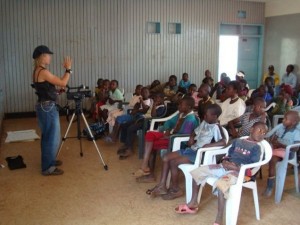 We are starting out with some popular perks from our previous Indiegogo campaign, Food Not Bombs t-shirts and copies of C.T.’s books, On Conflict and Consensus and Consensus for Cities.
We are starting out with some popular perks from our previous Indiegogo campaign, Food Not Bombs t-shirts and copies of C.T.’s books, On Conflict and Consensus and Consensus for Cities.
Doug is also making contact with some fair trade crafts cooperatives and exporters in Nairobi who may be willing to donate some of their jewelry and other crafts as perks for the campaign. So watch for additional perks!!!
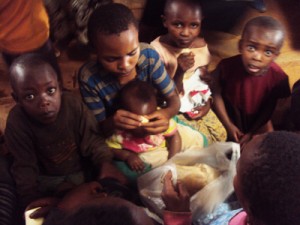 How can you get involved? Certainly, donating whatever you can is a huge start. Are you willing to join our campaign team and use Indiegogo share tools and social media to spread the word? Reaching out to people who don’t already know me, C.T. or Doug Rori is a great help.
How can you get involved? Certainly, donating whatever you can is a huge start. Are you willing to join our campaign team and use Indiegogo share tools and social media to spread the word? Reaching out to people who don’t already know me, C.T. or Doug Rori is a great help.
What ideas do you have for getting the word out about this impactful project?
If you’re in the D.C. region, C.T. and I can schedule a House Party with you. We can supply a slide show, talk about the project with friends you invite, and seek donations. Contact us at fiopa@consensus.net today to make arrangements!
Our main goals for now are to share this amazing story of risk, caring and daring and to get folks to visit our campaign page and donate. We must keep this work going!
When visiting the campaign site, do take the time to go through the photo gallery picture by picture. The interest of the kids in learning from Doug and his friends is amazing. You will understand from the numbers of people who attend that his offering is relevant and is making a difference.
What can you give today?
If This Is Evolution, What’s Next?
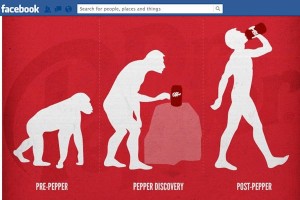 This controversy came across my screen this morning. Dr. Pepper is getting lots of free advertising from creationists who object to the soda’s variation on the March of Progress image. HERE is a fun site that collects a lot of spoof variants that, like most humor, are more honest in my opinion!
This controversy came across my screen this morning. Dr. Pepper is getting lots of free advertising from creationists who object to the soda’s variation on the March of Progress image. HERE is a fun site that collects a lot of spoof variants that, like most humor, are more honest in my opinion!
Of course, I had my first impulse that I must go out and get a Dr. Pepper, to quickly align myself on the side of my beliefs. Then I remembered my other beliefs—especially the one where I believe that putting such crap in my body is not a sign of progress, intelligence, or anything to wear proudly, such as on a red t-shirt, in an ocean of red t-shirts assembled to celebrate the individuality of Dr. Pepper drinkers.
What should the next image on the Dr. Pepper evolution look like? Someone keeled over with a stomach ulcer?
I’ve “evolved” to the point where I partake of a carbonated beverage probably three or four times per year. And I must say, when I go there, I like a Dr. Pepper. But at some point I heard that carbonated beverages in general inhibit the absorption of nutrients. So I tend to just skip them, or think of them as a forbidden pleasure.
I cut and paste this entire post from the hubpages article, What’s in My Food: Dr. Pepper Ingredients Explained:
Reading the ingredient list on your food label and knowing what they are, are two different things. For example: Do you know what the ingredients BHT, partially hydrogenated soybean oil, blue 1, and phosphoric acid are? Well you should, since you are consuming them on a daily basis. One’s use is banned in restaurants. Another is mined from the earth. And the Other two are made from petroleum.
Can you imagine what these ingredients are doing to your body? Well don’t imagine. Know. Educate yourself. Read on to learn exactly what your food is made of, and what it’s doing to your health.
In all products, ingredients must be listed according to their relative weight. The listing of each ingredient is in a descending order of predominance.
Dr Pepper ingredients are: Carbonated water, high fructose corn syrup, caramel color, phosphoric acid, natural and artificial flavors, sodium benzoate (preservative), caffeine.

1. Carbonated Water: Plain water into which carbon dioxide gas has been dissolved.
Health effects: Linked to tooth decay. May reduce fertility. Suspected teratogen (any agent that interferes with normal embryonic development).
2. High fructose corn syrup: Corn derived sweetener. Corn starch is processed to corn syrup and then treated with enzymes to convert glucose in fructose.
Health Effects: Excess may increase risk of tooth decay, abnormal weight gain, kidney stones, gout, kidney stones, colon cancer, and diabetes. Large amounts have caused tumors in mice. In 2005, some U.S. manufactured high fructose corn syrup was found to contain trace amounts of mercury.
3. Caramel Color: Brown food coloring and flavoring made by heating a sugar, usually corn syrup. May be processed with ammonia and sulfur to intensify color.
Health effects: May contain ammonium compounds. May affect stomach (gastrointestinal problems), liver, and cause hyperactivity. Caramel color produced with ammonia has been associated with blood toxicity in animals. Associated with reduced white cells and lymphocyte counts.
4. Phosphoric Acid: A colorless, odorless solution made from phosphate rock (not a food).
Health effects: May lead to calcium loss in bones and tooth erosion. Eye, skin, throat, nose, and respiratory irritant. Can cause osteoporosis. Linked to kidney damage and kidney stones.
*A corrosive, used to remove rust.
5. Natural flavors: Any flavor not chemically derived. Obtained by physical processes from plants or animals. Made to provide flavor to a food rather than nutritional value. May contain MSG.
Health effects: Unknown. Different foods use different natural flavors and processes. Naturally derived ingredients may be altered, rendered unsafe. It should be noted that the use of the word “natural flavors” is often used to mask the use of harmful, naturally derived flavors.
6. Artificial flavors: A synthetic mixture not found in nature, designed to mimic a natural flavor. May contain MSG. Over 1,700 artificial flavors are approved by the FDA.
Health effects: Unknown. Companies are not required to identify the various synthetic mixtures (1,700 to date) used in foods, requiring only that they be listed under the umbrella of the “artificial flavors” listing. Some individuals are sensitive to artificial flavors, experiencing headaches, nausea, and drowsiness, among other symptoms.
Artificial flavors sample list: benzyl isobutyrate, ethyl acetate, ethyl methylphenylglycidate (petroleum derivative), methyl benzoate (petroleum derivative), hydroxyphenyl-2-butanone. An artificial flavor may be made up of any number of synthetic chemicals.
7. Sodium benzoate: Used as a preservative. It is the sodium salt of Benzoic acid. Benzoic acid is synthesized commercially from toluene. Toluene is produced in the gasoline making process and the making of coke (carbon fuel produced by distillation of coal) from coal. Therefore, sodium benzoate is a petroleum derivative.
Health effects: Asthma, hives, hay fever, mouth irritation, and other allergic reactions. Neurotoxicity and brain damage; Linked to hyperactivity and decreased intellect in children. May cause DNA damage, leading to neurodegenerative diseases such as Alzheimer’s, and Parkinson’s.
Benzene, a known cancer-causing agent, can form in soft drinks when sodium benzoate and ascorbic acid (vitamin c, commonly added to fortify soft drinks) are present.
8. Caffeine: A bitter, white crystalline xanthine alkaloid that is a psychoactive stimulant drug.
Health effects: Psychoactive, addictive. May cause headaches/migraines, heart disease, depression. Causes birth defects in rats. Can cross the placental barrier. Inhibits fetal growth. Women who consume the amount of caffeine in one and a half to three cups of coffee may nearly double their risk of miscarriage.
Now you know the facts. You know what you are consuming, and can make an informed decision.
Owning Our Stories: Building a Silkscreen Press in Nairobi
 It’s always a good day when I wake up to surprise jpegs in my inbox. If you’ve kept up with Hippie Chick Diaries for any time, you know that photos are often the seeds of posts.
It’s always a good day when I wake up to surprise jpegs in my inbox. If you’ve kept up with Hippie Chick Diaries for any time, you know that photos are often the seeds of posts.
Here we see my partner, C.T. Butler, in Nairobi, Kenya, teaching a workshop in how to build a three color silkscreen press.
It was 2007 and C.T. was attending the IndyMedia Convergence in advance of the World Social Forum in Nairobi. When there’s a World Social Forum, 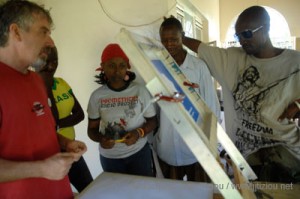 IndyMedia holds a convergence at the location, for a week or so before the event, teaching independent journalists and activists from around the world how to get their stories out using materials at hand. For example, workshops include building radios and transmitters from locally available materials.
IndyMedia holds a convergence at the location, for a week or so before the event, teaching independent journalists and activists from around the world how to get their stories out using materials at hand. For example, workshops include building radios and transmitters from locally available materials.
When their training is done, the journalists and activists are a well-bonded collective that then covers the World Social Forum.
C.T. attended the Nairobi convergence at the invitation of IndyMedia (aka IMC). C.T. is cofounder of the movement Food Not Bombs. The two groups have many cross connections and cross pollinations. Like Food Not Bombs before it, IndyMedia is leaderless, focused on local groups, horizontal in structure, consensus-based, etc.
C.T.’s primary focus was teaching consensus to convergence participants, but his experience in the early days of both FNB and IMC taught him do-it-yourself skills like building a silkscreen press by hand. C.T. often built and used makeshift silkscreen presses in his activism on the east and west coasts of the US.
Activists used the silkscreens to make three color posters, fliers and t-shirts at low cost. Many people are walking around today in Food Not Bombs t-shirts screened by C.T.
 But when C.T. tried to teach this DIY information-sharing tool with activists in Kenya, it was not so easy. Several cultural differences got in the way. First, The most of the African students had not ever held tools like screwdrivers and hammers. Not a universal part of the upbringing.
But when C.T. tried to teach this DIY information-sharing tool with activists in Kenya, it was not so easy. Several cultural differences got in the way. First, The most of the African students had not ever held tools like screwdrivers and hammers. Not a universal part of the upbringing.
Second, there was no Home Depot to go and buy all the supplies and tools. Instead, Nairobi marketplaces had little shops that specialized. There might be an entire shop for screws. That’s all they would have. New, used, mystery screws, chocolate screws, Martian screws…they would have it all, but C.T. found himself going to a dozen different shops, 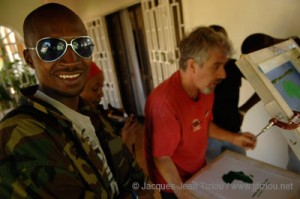 sometimes more than once. Lumber was an odyssey unto itself.
sometimes more than once. Lumber was an odyssey unto itself.
I came into these photos because our friend Doug Rori, in the camouflage jacket, is working with us on a new Indiegogo campaign to fund his work with A Well-Fed Kenya. (More on A Well-Fed Kenya in upcoming posts!) I asked him for pictures of the two of them together, to help tell the story of our collaboration.
I love that what he found were pictures of the silkscreen workshop. C.T. had told me the story several times and it captures my imagination to realize the ways we can take our power back. If we can mass produce our own newspapers, t-shirts, posters, etc., with found materials, then we control our message, we own our stories. This is the profound power of the silkscreen press workshop, like all the others during the IndyMedia Convergence.
[Activists in Mexico made entire copies of C.T.'s book, Food Not Bombs: How to Feed the Hungry and Build Community, in Spanish, on a silkscreen press. His copy is one of his treasured possessions!]
The students and C.T. made a press that day. And today Doug and I will launch our Indiegogo campaign to get the message out about a really amazing, holistic project that feeds many people and teaches them the skills of getting their own messages out every day. Stay tuned!


